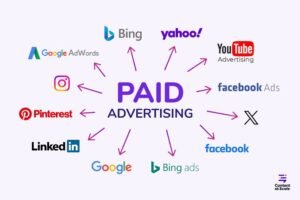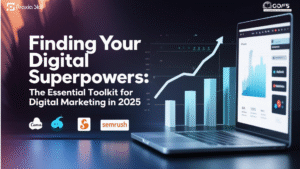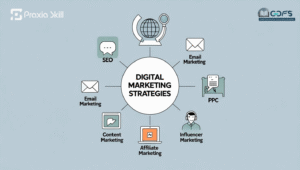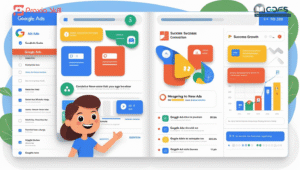Ever wondered how Google shows you that exact product you were just thinking about? Or how Instagram knows what you might want to buy next? That’s the power of paid advertising — a digital strategy that helps brands get noticed, faster.
In today’s crowded online world, simply having a website or social media profile isn’t enough. To stand out and reach the right audience at the right time, businesses often rely on online advertising. And paid advertising is one of the most effective ways to do just that.
In this beginner-friendly guide, we’ll break down what paid advertising is, how it works, the different types of paid ads, and why it matters — especially if you’re just starting out in the world of digital marketing.
What is Paid Advertising?
Paid advertising refers to any online promotion where businesses pay to place their content in front of specific audiences. This could be in the form of ads on search engines, social media platforms, websites, or even videos.
In simple terms, paid advertising is like renting space online to showcase your brand, product, or message — with the goal of getting more visibility, clicks, and conversions.
It differs from organic advertising, which relies on unpaid methods like search engine optimisation (SEO), content marketing, or social media posts that grow reach over time.
Common Examples:

- Google Search Ads
- Facebook and Instagram Ads
- YouTube Video Ads
- LinkedIn Sponsored Posts
Why Do Brands Use Paid Ads?
With millions of businesses competing online, relying solely on organic reach can be slow and uncertain. That’s why many companies — from startups to global brands — invest in paid ads. Here’s why:
- Instant Visibility: Appear in front of your target audience within minutes of launching a campaign.
- Targeted Reach: Show ads to specific demographics, interests, locations, or behaviours.
- Budget Control: Set daily or total ad spend limits based on your business goals.
- Measurable Results: Track performance in real-time with clicks, impressions, conversions, and ROI data.
Common Types of Paid Advertising
There are several types of paid ads, each with its own strengths depending on your business needs:
1. Search Engine Ads (Google/Bing Ads)
These appear at the top of search engine results when users type in keywords. For example, if someone searches “buy running shoes,” a paid ad from a shoe brand may appear first.
2. Social Media Ads (Facebook, Instagram, LinkedIn, Twitter)

Social platforms allow you to promote posts, pages, or products to specific user segments based on age, interests, or location.
3. Display Ads
These are visual banner ads that appear on websites and apps. They help with brand awareness and retargeting visitors who previously viewed your site.
4. Video Ads
Platforms like YouTube and OTT apps allow short video ads before or during content. These are highly engaging and ideal for storytelling.
5. Influencer Paid Promotions
Brands partner with social media influencers to promote their products through sponsored content or shoutouts.
6. Affiliate Marketing Ads
You pay a commission to affiliates who promote your product and drive traffic or sales through their unique tracking links.
How Does Paid Advertising Work?
Most online advertising platforms operate on a bidding system. You choose how much you’re willing to pay for a click, impression, or conversion — and the platform displays your ad accordingly.
Here are some key terms to understand:
- PPC (Pay Per Click): You only pay when someone clicks your ad. Common in search ads.
- CPM (Cost Per Mille): You pay for every 1,000 views (impressions). Ideal for brand awareness.
- CPA (Cost Per Action): You pay only when a user takes a specific action (like a purchase or signup).
Platforms like Google and Meta use complex algorithms to decide which ads appear, considering your bid amount, ad relevance, and expected engagement.
Paid Ads vs Organic Marketing
| Feature | Paid Advertising | Organic Marketing |
|---|---|---|
| Cost | Requires direct spend | Free but time-consuming |
| Speed | Instant visibility | Slower growth |
| Control | High targeting and placement control | Limited control |
| Sustainability | Stops when budget ends | Long-term value |
| Use Case | Fast results, launches, offers | Long-term brand building |
Real Benefits of Paid Advertising
Whether you’re running a small business or launching a new product, the benefits of paid marketing are hard to ignore:
- Faster Results: No waiting for SEO rankings. Your ad goes live immediately.
- Brand Visibility: Reach people who have never heard of your brand before.
- Higher Conversion Rates: Targeted ads bring more qualified leads.
- Data & Insights: Analyse performance metrics to refine future campaigns.
- A/B Testing: Try different versions of an ad to see what works best.
Tips for Beginners Getting Started with Paid Ads
Just starting out with digital marketing? Here are simple tips to make your first campaign count:
- Set Clear Goals: Decide whether you want traffic, leads, or sales.
- Start Small: Begin with a low budget and test different strategies.
- Know Your Audience: Use targeting tools to focus on the right users.
- Create Strong Landing Pages: Ensure users land on pages that match the ad and include a clear call-to-action (CTA).
- Monitor & Optimise: Check your analytics regularly and make improvements as needed.
Conclusion
Paid advertising isn’t just for big brands with deep pockets — it’s a powerful tool that any business can use to grow online. When done right, it can boost your reach, attract quality leads, and help you stay ahead in the digital game.
Whether you’re a startup founder, marketer, or small business owner, paid ads can be the fast lane to online growth. The key is to start simple, keep testing, and focus on what your audience truly cares about.
Ready to boost your visibility? Dive into paid advertising — and watch your business go beyond the scroll.



